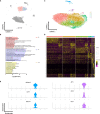Single-Cell RNA Sequencing of Human Corpus Cavernosum Reveals Cellular Heterogeneity Landscapes in Erectile Dysfunction
- PMID: 35518933
- PMCID: PMC9066803
- DOI: 10.3389/fendo.2022.874915
Single-Cell RNA Sequencing of Human Corpus Cavernosum Reveals Cellular Heterogeneity Landscapes in Erectile Dysfunction
Abstract
Purpose: To assess the diverse cell populations of human corpus cavernosum in patients with severe erectile dysfunction (ED) at the single-cell level.
Methods: Penile tissues collected from three patients were subjected to single-cell RNA sequencing using the BD Rhapsody™ platform. Common bioinformatics tools were used to analyze cellular heterogeneity and gene expression profiles from generated raw data, including the packages Seurat, Monocle, and CellPhoneDB.
Results: Disease-related heterogeneity of cell types was determined in the cavernous tissue such as endothelial cells (ECs), smooth muscle cells, fibroblasts, and immune cells. Reclustering analysis of ECs identified an arteriole ECs subcluster and another one with gene signatures of fibroblasts. The proportion of fibroblasts was higher than the other cell populations and had the most significant cellular heterogeneity, in which a distinct subcluster co-expressed endothelial markers. The transition trajectory of differentiation from smooth muscle cells into fibroblasts was depicted using the pseudotime analysis, suggesting that the expansion of corpus cavernosum is possibly compromised as a result of fibrosis. Cell-cell communications among ECs, smooth muscle cells, fibroblasts, and macrophages were robust, which indicated that inflammation may also have a crucial role in the development of ED.
Conclusions: Our study has demonstrated a comprehensive single-cell atlas of cellular components in human corpus cavernosum of ED, providing in-depth insights into the pathogenesis. Future research is warranted to explore disease-specific alterations for individualized treatment of ED.
Keywords: RNA-seq; endothelial cells; erectile dysfunction; fibroblasts; single-cell analysis; smooth muscle cells.
Copyright © 2022 Fang, Tan, Song, Gu, Pan, Yang, Song, Yuan, Peng, Zhang, Xin, Li and Guan.
Conflict of interest statement
The authors declare that the research was conducted in the absence of any commercial or financial relationships that could be construed as a potential conflict of interest.
Figures






Similar articles
-
Single-cell transcriptome atlas of the human corpus cavernosum.Nat Commun. 2022 Jul 25;13(1):4302. doi: 10.1038/s41467-022-31950-9. Nat Commun. 2022. PMID: 35879305 Free PMC article.
-
Heterogeneity of fibroblasts is a hallmark of age-associated erectile dysfunction.Int J Biochem Cell Biol. 2023 Mar;156:106343. doi: 10.1016/j.biocel.2022.106343. Epub 2022 Dec 9. Int J Biochem Cell Biol. 2023. PMID: 36503049
-
Human neural crest stem cells transplanted in rat penile corpus cavernosum to repair erectile dysfunction.BJU Int. 2008 Jul;102(2):220-4; discussion 224. doi: 10.1111/j.1464-410X.2008.07469.x. Epub 2008 Jul 1. BJU Int. 2008. PMID: 18284412
-
The physiological role of androgens in penile erection: regulation of corpus cavernosum structure and function.J Sex Med. 2005 Nov;2(6):759-70. doi: 10.1111/j.1743-6109.2005.00094.x. J Sex Med. 2005. PMID: 16422801 Review.
-
Erectile physiological and pathophysiological pathways involved in erectile dysfunction.J Urol. 2003 Aug;170(2 Pt 2):S6-13; discussion S13-4. doi: 10.1097/01.ju.0000075362.08363.a4. J Urol. 2003. PMID: 12853766 Review.
Cited by
-
Penile cavernous sinusoids are Prox1-positive hybrid vessels.Vasc Biol. 2024 Jan 11;6(1):e230014. doi: 10.1530/VB-23-0014. Print 2024 Jan 1. Vasc Biol. 2024. PMID: 38051669 Free PMC article.
-
Identification of fibrosis-related genes and biomarkers in diabetic erectile dysfunction.Sex Med. 2025 Jan 9;12(6):qfae090. doi: 10.1093/sexmed/qfae090. eCollection 2024 Dec. Sex Med. 2025. PMID: 39790563 Free PMC article.
-
Study on the mechanism of aging-related erectile dysfunction based on bioinformatics and experimental verification.Transl Androl Urol. 2023 Feb 28;12(2):197-208. doi: 10.21037/tau-22-511. Epub 2023 Feb 3. Transl Androl Urol. 2023. PMID: 36915879 Free PMC article.
-
Single-cell transcriptome analyses reveal the mechanism of mitochondrial activity in erectile dysfunction.Sex Med. 2025 Jul 20;13(3):qfaf049. doi: 10.1093/sexmed/qfaf049. eCollection 2025 Jun. Sex Med. 2025. PMID: 40689149 Free PMC article.
-
Identification of Systemic Drug Targets for Anti-cavernous Fibrosis in the Treatment of Erectile Dysfunction, Guided by Genome-Wide Mendelian Randomization.Am J Mens Health. 2025 Mar-Apr;19(2):15579883251323187. doi: 10.1177/15579883251323187. Epub 2025 Mar 12. Am J Mens Health. 2025. PMID: 40077914 Free PMC article.
References
Publication types
MeSH terms
LinkOut - more resources
Full Text Sources
Medical

